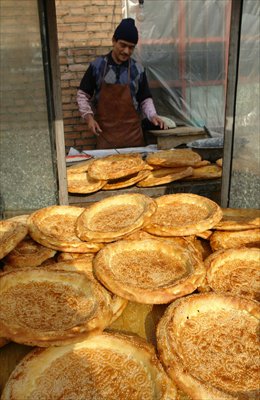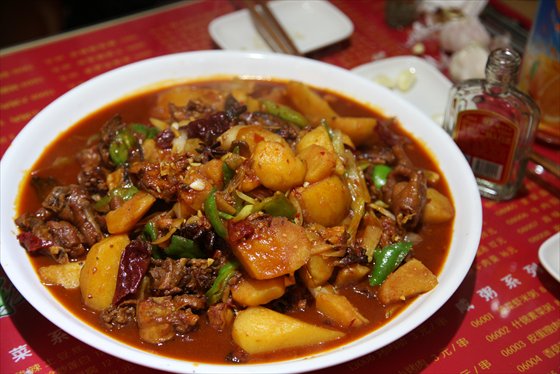Flavors of Xinjiang

Flat bread Photo: CFP

Big plate chicken Photo: CFP
Out on the northwestern edge of China is the land of Xinjiang Uyghur Autonomous Region. As its name, meaning new frontier, implies it's a place that has long served as a gateway to the rest of the nation.
It's here that the Silk Road sees its last leg in China. Flowing out through Xinjiang went the wares and culture from China.
In came travelers hailing from Central Asia and Europe. All of this resulted in a cuisine that broadens the definition of what Chinese cuisine can be.
Unlike the eight great cuisines that many see as defining Chinese food, this land packs a whole other set of flavors.
Gone are soy sauce, vegetable centric dishes and even chopsticks. In its place are a set of tastes that evolved out of a seemingly inhospitable landscape that is the desert.
Instead of merely tradition dictating meal preparation, Halal food laws are what the local Muslim families follow.
That means the pork that is the meat of choice back East, here is nowhere to be seen.
Instead in its place is a repertoire of lamb dishes among others that go far beyond the skewers of mutton that are the only reference point for this cuisine to many.
Flat bread
By the ornate bronze grills that sit outside many Xinjiang restaurants are stacks of a circular bread called nang. Like the similar sounding naan of India, this type of flat bread comes out of dome-shaped ovens where it is cooked along the curving sides.
These breads are forged from a simple leavened dough that is flat and thin in the center and kneaded into a fat ridge along the edges. Before going into the oven it is stamped with designs that vary by region and kitchen, plus a final sprinkle of sesame seeds.
While there are many noodle and rice dishes in the region's cookbooks, this bread is one of the main forms of grain eaten daily. It's a hearty bread like the surrounding land that is capable of lasting weeks without spoilage.
Beyond being enjoyed straight up there are renditions that top it with lamb ribs, a tomato sauce and a sprinkle of colorful cilantro and onions.
Eaten by hand it is a like a pizza where the ratio of crust to toppings has been beautifully skewed in the direction of meat.
Hand grabbed lamb & rice
Fried rice is one of the best known Chinese dishes. To see an entirely different rendition of this classic cast your appetite in the direction of hand grabbed rice, shou zhua fan.
If its name wasn't clear enough this is a dish that you need to put down the chopsticks and use nature's utensil, your hands, to enjoy.
This dish begins with plump grains of cooked white rice added to a wok with plenty of rendered lamb fat.
Next goes in medium diced carrots, which seem like a rare ingredient in this meat centric cuisine. Finally chunks of already cooked lamb are added.
Eating this by hand solves the difficulty of eating a rice dish that isn't sticky enough to use chopsticks.
Also it adds a new element into the mix, texture felt by hand. To be done properly, the diner should use all five fingers and work the rice into a ball.
Big plate chicken
For a glimpse beyond the lamb that seems to define this style is the epic dish known as da pan ji, or big plate chicken.
On a plate big enough for a Sunday roast is a mountain of thick noodles on the bottom and a stack of one whole chicken, potatoes and a dose of green peppers on top. Uniting it all together is a spicy gravy that skews flavor wise in the direction of tomato.
Like the many other dishes in Xinjiang evolved out of travelers, this one dates back to the larger-than-life appetites of long haul trucks who plied this land.
The story goes that these drivers who had traveled many thousands of kilometers to arrive in Xinjiang had a mighty hunger by the time they arrived.
So at truck stops and roadside diners these drivers would ask for a plate of noodles and an order of chicken and combine it all together.
Go beyond the sticks of lamb and you'll see another side of this region's cuisine. It truly is a new frontier of flavor.